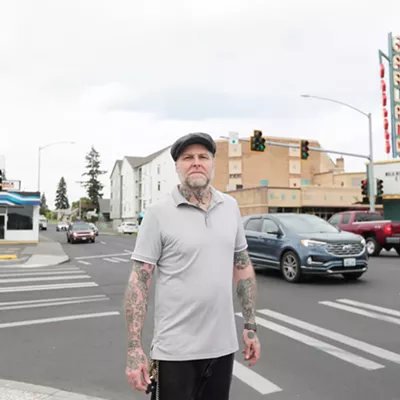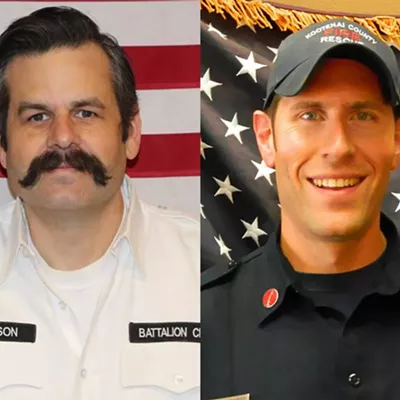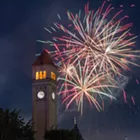In one form or another, bridges have spanned the Spokane River gorge at Monroe Street since 1888. With an ever-growing population and demand for traversing the river increasing, a wooden structure was built to get goods and people from one side of town to the other. The wood succumbed to fire and was subsequently replaced by steel -- and when that didn't work, the city finally decided on a cement structure. Not just any cement structure, however - city leaders built the largest cement bridge in the country and third-largest in the world at the time of its construction. Spokane architect Kirtland Cutter even added the steer skull design flourishes to the crossing. Now the bridge has served the community for the past 94 years.
In the late '90s, however, the grand old span began to show severe signs of deterioration, and the city ordered an assessment of the bridge's overall condition. David Evans & amp; Associates did the initial assessment, and their finding was that the entire structure was in poor shape and the bridge had about seven years of average use left until it would need extensive updating. Planning a solution to the bridge problem began immediately.
"There were three options we had for this project," says Dick Raymond, the city Public Works principal engineer on the project. "We could build an entirely new structure, do a patch job on the existing bridge or do a complete restoration."
After careful consideration, the city decided to move forward with a comprehensive restoration project. "It would have been easier to build a new bridge," says Raymond. But the endeavor would prove worthwhile.
It was no secret a new structure would have been the path of least resistance, but city officials and preservation advocates understood the significance of the bridge to the community. A 30-month plan totaling $20 million was put into effect in January 2003 to bring the bridge up to today's standards with minimal deviation from the original design. The restoration called for total reconstruction of the deck, the small arches that line the north and south approach of the bridge and thorough reconditioning of the main arch and the piers. The existing work done on the main arch was so over-designed when it was built that it didn't need to be rebuilt -- a credit to the original designer of the bridge, J.C. Ralston. The restored bridge would be a feat of engineering and a culmination of ingenuity and vision among the designers, contractor and the city.
The bold undertaking of this project fell to Wildish F.E. Ward contractors. Working closely with Jerry Sinclair from the city, the contractor moved ahead with fervor on the project. The firm has a reputation for impressive work, as well as being able to complete projects on time and on budget. Some of the challenges that faced the contractor could have delayed the completion of the bridge. One such delay was a sudden spike in steel prices.
"The reinforcing bar costs increased drastically, which resulted in some cost escalation," explains Raymond. An additional challenge was building debris decks underneath the construction site to ensure that no harmful substances would make their way into the river below. "We were totally impressed with the attention to detail and their desire to do the right thing," says Raymond. "They take safety very seriously, and that was apparent on this project."
An illustration of just how important safety was on the project as a whole occurred when the contractor's lead carpenter was found on the bridge without a safety line -- and he was let go from the company. There were no serious accidents or injuries during the construction -- another example of the emphasis Wildish F.E. Ward put on safety.
The restoration of the bridge wasn't without its surprises. When workers removed the street deck, they discovered a secret the bridge had kept since it was built. A 94-year stockpile of pigeon droppings reared its ugly head and put everyone on the project aback. Workers had to remove 22 tons -- that's right, tons -- of droppings from the site by hand and have them trucked away, as well ensuring that none of it dropped into the river.
There was also a scare when the possibility arose that the pier at the south end of the south arch might have to be replaced. Fortunately, unlike the pier at the north end of the north arch (which was hollow), this pier was solid concrete and was repairable. "Having to replace that pier could have delayed the project to next year. We were very fortunate," says Raymond.
All things considered, this endeavor went about as well as could be expected. There were no major delays and no major accidents, and the project will be finished on time and on budget.
To commemorate the reopening of the bridge, City Cable 5 will air a one-hour documentary about the bridge periodically. Produced by city audio video technician Dan Archer, and helped along by station director John Delay, the program chronicles the history of the region from the focal point of the bridge.
"I probably put close to 200 hours in on this project, just fitting it in where ever I could," says Archer -- so much time, in fact, that employees of the Northwest Museum of Arts & amp; Culture know him by name. "This project was a lot of fun for me," Archer adds. "History was my minor, so I already had the interest."
For Archer, it was unique to see the way things have changed in Spokane just during the lifespan of the bridge. "We put together about three times more programming than cities that are four times our size in population," says Delay. "A program like this uncovers what an interpretation of history is. It is always a little different according to who you talk to -- it's just in the way it is presented."
From a historical standpoint, the complexity of the bridge restoration could have been cause for major problems and unforeseeable delays. However, everything fell into place. Raymond sums up the extraordinary accomplishment this way:
"People who compare this structure with the original will be very pleased with the appearance. There are just some subtle changes. We are hoping they will see it and say, 'Oh, yeah, that's the Monroe Street Bridge.' I feel truly blessed to have worked on this project. I very much wanted to be a part of it. Considering this project as a bridge construction, it's not terribly important -- but as a restoration project and considering it nationally, it is very significant. This was a once-in-a-career kind of thing."
Festivities for the reopening of the Monroe Street Bridge will run from Sept. 16-18. On Friday, Sept. 16, at 5 pm, there will be a Pre-Opening Night Gala hosted by the Spokane Preservation Advocates. Tickets: $75. Call 325-SEAT. On Saturday, Sept. 17, at 11 am, join in the bridge's opening ceremony, followed by a day of activities. On Sunday, Sept. 18, there will be a worship celebration on the bridge at 8:30 am and then the Connie Prekeges 5K Memorial Walk for Cancer at 9:30 am. Donations requested. Call 625-6740. You are free to drive on the new bridge starting Sept. 18.















